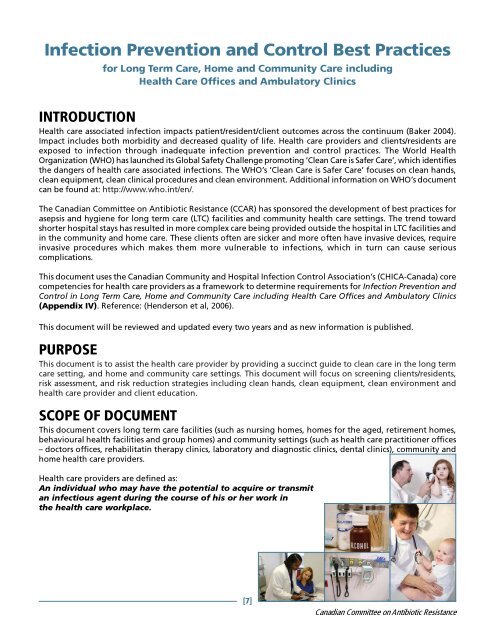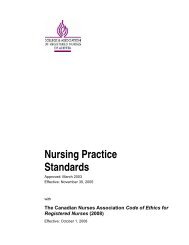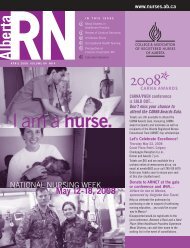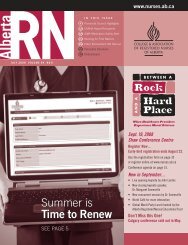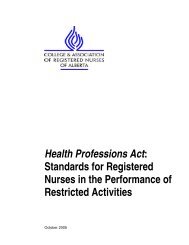Infection Prevention and Control Best Practices - College ...
Infection Prevention and Control Best Practices - College ...
Infection Prevention and Control Best Practices - College ...
You also want an ePaper? Increase the reach of your titles
YUMPU automatically turns print PDFs into web optimized ePapers that Google loves.
INFECTION PREVENTION AND CONTROL BEST PRACTICES<br />
FOR LONG TERM CARE AND COMMUNITY CARE INCLUDING HEALTH CARE OFFICES AND AMBULATORY CLINICS<br />
for Long Term Care, Home <strong>and</strong> Community Care including<br />
Health Care Offices <strong>and</strong> Ambulatory Clinics<br />
<strong>Infection</strong> <strong>Prevention</strong> <strong>and</strong> <strong>Control</strong> <strong>Best</strong> <strong>Practices</strong><br />
INTRODUCTION<br />
Health care associated infection impacts patient/resident/client outcomes across the continuum (Baker 2004).<br />
Impact includes both morbidity <strong>and</strong> decreased quality of life. Health care providers <strong>and</strong> clients/residents are<br />
exposed to infection through inadequate infection prevention <strong>and</strong> control practices. The World Health<br />
Organization (WHO) has launched its Global Safety Challenge promoting ’Clean Care is Safer Care’, which identifies<br />
the dangers of health care associated infections. The WHO’s ‘Clean Care is Safer Care’ focuses on clean h<strong>and</strong>s,<br />
clean equipment, clean clinical procedures <strong>and</strong> clean environment. Additional information on WHO’s document<br />
can be found at: http://www.who.int/en/.<br />
The Canadian Committee on Antibiotic Resistance (CCAR) has sponsored the development of best practices for<br />
asepsis <strong>and</strong> hygiene for long term care (LTC) facilities <strong>and</strong> community health care settings. The trend toward<br />
shorter hospital stays has resulted in more complex care being provided outside the hospital in LTC facilities <strong>and</strong><br />
in the community <strong>and</strong> home care. These clients often are sicker <strong>and</strong> more often have invasive devices, require<br />
invasive procedures which makes them more vulnerable to infections, which in turn can cause serious<br />
complications.<br />
This document uses the Canadian Community <strong>and</strong> Hospital <strong>Infection</strong> <strong>Control</strong> Association’s (CHICA-Canada) core<br />
competencies for health care providers as a framework to determine requirements for <strong>Infection</strong> <strong>Prevention</strong> <strong>and</strong><br />
<strong>Control</strong> in Long Term Care, Home <strong>and</strong> Community Care including Health Care Offices <strong>and</strong> Ambulatory Clinics<br />
(Appendix IV). Reference: (Henderson et al, 2006).<br />
This document will be reviewed <strong>and</strong> updated every two years <strong>and</strong> as new information is published.<br />
PURPOSE<br />
This document is to assist the health care provider by providing a succinct guide to clean care in the long term<br />
care setting, <strong>and</strong> home <strong>and</strong> community care settings. This document will focus on screening clients/residents,<br />
risk assessment, <strong>and</strong> risk reduction strategies including clean h<strong>and</strong>s, clean equipment, clean environment <strong>and</strong><br />
health care provider <strong>and</strong> client education.<br />
SCOPE OF DOCUMENT<br />
This document covers long term care facilities (such as nursing homes, homes for the aged, retirement homes,<br />
behavioural health facilities <strong>and</strong> group homes) <strong>and</strong> community settings (such as health care practitioner offices<br />
– doctors offices, rehabilitatin therapy clinics, laboratory <strong>and</strong> diagnostic clinics, dental clinics), community <strong>and</strong><br />
home health care providers.<br />
Health care providers are defined as:<br />
An individual who may have the potential to acquire or transmit<br />
an infectious agent during the course of his or her work in<br />
the health care workplace.<br />
[7]<br />
Canadian Committee on Antibiotic Resistance


